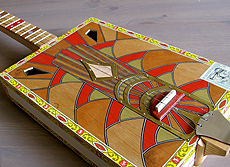Fermilab Art Gallery, Arts and Lecture Series join together to bring the noise
 |
"La Gloria Cubana" by Jeremiah Lee is on display as part of the exhibit "On That Note" in the Fermilab Art Gallery. The exhibit will be up until Sept. 10. |
On the second floor of Wilson Hall, embedded in a series of nine 12-by-12-inch prints, there is a lithograph of a girl floating against a brick wall. The image is full of holes: The wall is spotted with them, and the girl, who is entangled in vines, has a hole in her chest.
"It's about missing somebody," said Deborah Lader, the artist. "It's as simple as that."
Lader, who is also a musician, recorded a song to accompany the print. Both works belong to a portfolio titled "Soundcheck," a collection of music and handmade prints from Lader's workshop, the Chicago Printmakers Collaborative. The portfolio is currently featured in the Fermilab Art Gallery as part of an exhibit called "On That Note." The exhibit, which runs until Sept. 10, highlights artists who deal with visual sound and the exploration of music through art.
Guitars made from cigar boxes and oak, laser-cut wood reliefs that turn tunes such as "Twinkle, Twinkle Little Star" into geometric forms, historic tintypes of musicians, and a giant map of Chicago stretched across the wall like a drum are just some of the ways artists chose to visualize sound. In the corner of the gallery, Erik Ramberg's piece, "Dark Music in the Deep," lights up red and white as it translates dark matter data from the CDMS experiment in Minnesota into different noises. The exhibit features two Fermilab employees: Ramberg, in the Particle Physics Division, and Chris Olsen, the photographer of the historic tintypes, in the Accelerator Division.
To continue the theme of music and art, Lader's band, Sons of the Never Wrong, will play a concert after the artist reception on July 18 as part of the Fermilab Arts and Lecture Series. Lader said with a laugh that although they're a folk trio, folkies think they're not folksy enough. This will be the second time that Sons of the Never Wrong have performed at Fermilab.
For Georgia Schwender, Fermilab Art Gallery curator, one of the most exciting things about the exhibit is the collaboration of performing and visual arts. Schwender said that while Fermilab has a strong visual program and a strong performing arts program, when you put them together they become even more compelling.
"Taking what exists and combining it to make it more powerful is the crux of this show," Schwender said. "It's like a puzzle. You put all these pieces together and you get something really complete."
The artist reception for "On That Note" will take place on Saturday, July 18, from 5-7 p.m. Tickets for the Sons of the Never Wrong concert on July 18 at 8 p.m. are available for purchase at the door or by calling 630-840-2787.
—Ali Sundermier
|